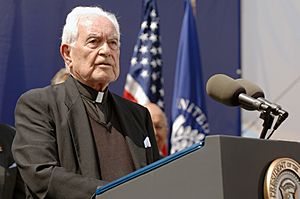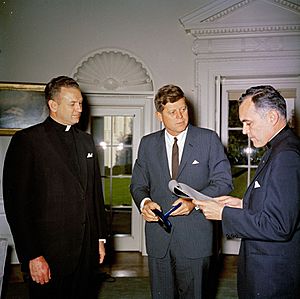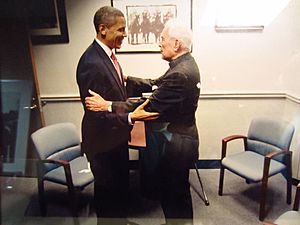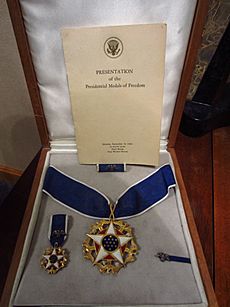Theodore Hesburgh facts for kids
Quick facts for kids
Theodore Hesburgh
|
|
|---|---|

Hesburgh in 2008
|
|
| 15th President of the University of Notre Dame | |
| In office 1952–1987 |
|
| Preceded by | John J Cavanaugh |
| Succeeded by | Edward Malloy |
| Chair of the United States Commission on Civil Rights | |
| In office 1969–1972 |
|
| President | Richard Nixon |
| Preceded by | John A. Hannah |
| Succeeded by | Arthur S. Flemming |
| Personal details | |
| Born |
Theodore Martin Hesburgh
May 25, 1917 Syracuse, New York, U.S. |
| Died | February 26, 2015 (aged 97) Notre Dame, Indiana, U.S. |
| Resting place | Holy Cross Cemetery |
| Education | Pontifical Gregorian University (BA) College of the Holy Cross Catholic University (MA, PhD) |
| Signature | |
| Theodore Hesburgh | |
|---|---|
| Orders | |
| Ordination | 24 June 1943 |
| Personal details | |
| Denomination | Catholic Church |
Theodore Martin Hesburgh (May 25, 1917 – February 26, 2015) was a Catholic priest and a very important leader in education. He was a member of the Congregation of Holy Cross. Father Hesburgh is best known for being the president of the University of Notre Dame for 35 years. This was from 1952 to 1987.
Besides his work as an educator, Hesburgh was also a public servant. He helped with many important projects in the U.S. and around the world. He worked on civil rights, peaceful uses of atomic energy, and helping other countries. He received many awards for his service. These included the Presidential Medal of Freedom and the Congressional Gold Medal. He also holds the world record for the most honorary degrees, with over 150.
Hesburgh helped Notre Dame become a top university. It was once mostly known for its football team. He oversaw its big growth and helped it become a coeducational school. This meant both boys and girls could attend. He also helped transfer the university's ownership.
Contents
Early Life and Education
Theodore Martin Hesburgh was born in Syracuse, New York, on May 25, 1917. His father worked for a glass company. His mother's family was from Ireland. Theodore was the second of five children. He had two brothers and three sisters.
He went to a local school called Most Holy Rosary. He also served as an altar boy at church. Hesburgh said he wanted to be a priest from age six. A missionary priest from the Congregation of Holy Cross encouraged him. This group owned the University of Notre Dame.
Hesburgh finished high school in 1934. He then joined the Holy Cross Seminary at Notre Dame. In 1937, his teachers sent him to study in Rome, Italy. He earned a philosophy degree there in 1940. When World War II started, he returned to the U.S. He studied theology for three years. Then he studied at The Catholic University of America. He earned his doctorate in sacred theology in 1945.
On June 24, 1943, Hesburgh became a priest. This happened at Notre Dame's Sacred Heart Church. He dedicated his life to "God, Country, and Notre Dame." After this, Father Ted, as he liked to be called, finished his studies. He also helped at churches in Washington, D.C.. He worked as a chaplain at a juvenile detention center. He also ran a large club for soldiers. He wanted to be a Navy chaplain during the war. But he returned to Notre Dame in 1945 to teach.
Leading Notre Dame University
Starting His Career at Notre Dame
Hesburgh began teaching at Notre Dame in 1945. He taught in the religion department. In 1948, he became head of the theology department. The university president, John J. Cavanaugh, then made him executive vice president in 1949. Just three years later, at age 35, Hesburgh became president of Notre Dame.
Becoming President of Notre Dame

Hesburgh was Notre Dame's president for 35 years. He retired in 1987. This was the longest time anyone had been president of a U.S. university. He immediately worked to change the school. He wanted it to be known for its academics, not just football. In 1953, he started a program to bring top scholars to Notre Dame. By 1987, the school had over 100 distinguished professors.
During his time, Notre Dame grew a lot. Its money for future projects increased greatly. In 1972, it also became a coeducational school. This meant women could attend classes there. The university's budget and research funding grew significantly. Student enrollment almost doubled. The number of teachers also more than doubled.
Hesburgh also started 40 new building projects. One was the $8 million Hesburgh Library. This library has the famous "Word of Life" mural. People often call it "Touchdown Jesus."
Hesburgh helped create the Land O'Lakes Statement in 1967. This document said that Catholic universities should have academic freedom. They should be independent from all authority, even the Catholic Church. This idea caused some debate. But Hesburgh's focus on quality made Notre Dame famous. In 1967, he changed how the university was run. Ownership moved from the Holy Cross priests to a new board. This board included both priests and other leaders.
Student Protests and Civil Rights
In the 1960s, many students protested across the U.S. Notre Dame also had student unrest. On February 17, 1969, Hesburgh took a strong stand. He sent a letter to students about anti-Vietnam War protests. He said students who broke rules would get 15 minutes to stop. If they didn't, they would be suspended or expelled.
This decision caused a lot of discussion. It was reported in major newspapers. Many people supported Hesburgh's "fifteen-minute rule." President Richard Nixon even praised his strong action. Hesburgh advised Vice President Spiro Agnew on controlling campus violence. He believed universities should handle their own protests. He also publicly opposed the Vietnam War.
Hesburgh was a leader in civil rights. He chaired the United States Commission on Civil Rights. But Notre Dame was slow to end institutional racism. In 1969, black students criticized the low number of minority students. Hesburgh then took steps to hire more minority staff. He also worked to recruit more minority students. He used money from Notre Dame's football games to fund scholarships for minorities.
In May 1970, there were rumors of a firebombing at Notre Dame. Hesburgh spoke to students on May 4. He spoke against the war and Nixon's actions in Cambodia. He also suggested ways the government could address student concerns. This speech became known as the Hesburgh Declaration. Notre Dame's protests ended without violence. Other campuses, like Columbia University, had more serious issues.
By the early 1970s, Hesburgh was a well-known American Catholic leader. He continued to involve students in university decisions.
Public Service and Global Impact
Working with the U.S. Government
Hesburgh spent about 40% of his time on civic activities. He believed this work made his priesthood richer. Starting in 1955, he served on many government groups. These included the National Science Board and the U.S. Civil Rights Commission. He also worked with non-profit groups like the Rockefeller Foundation.
He had at least 16 appointments from U.S. presidents. These involved major issues like civil rights and immigration. His first appointment was in 1954. President Dwight Eisenhower named him to the National Science Board. In 1957, Eisenhower made him a member of the U.S. Civil Rights Commission. Hesburgh became a strong voice for civil rights.
In 1961, Hesburgh helped start a Peace Corps project at Notre Dame. He felt President John F. Kennedy did not do enough for civil rights. But he praised President Lyndon B. Johnson for passing the Civil Rights Act of 1964. He also supported the Voting Rights Act of 1965. Hesburgh joined Martin Luther King Jr. at a civil rights rally in Chicago in 1964. They sang "We Shall Overcome" together.
Hesburgh chaired the U.S. Civil Rights Commission from 1969 to 1972. President Nixon asked him to resign in 1972. This was after disagreements about civil rights policies. Hesburgh disagreed with Nixon's slow approach to school desegregation. He also opposed Nixon's anti-busing policy. He believed his dismissal was due to a report on minority employment in government.
In the 1970s, Hesburgh supported the Equal Rights Amendment. This amendment aimed to ensure equal rights for all citizens. In 1979, President Jimmy Carter appointed Hesburgh to an immigration reform group. This group's work led to the Refugee Act of 1980.
Working with the Vatican
Hesburgh also had important roles with the Holy See (the Vatican). From 1956 to 1970, he represented the Vatican. He worked with the International Atomic Energy Agency in Vienna, Austria. Pope Paul VI appointed him to lead Vatican representatives. They attended the 20th anniversary of the UN's human rights declaration. Pope John Paul II also appointed him to the Pontifical Council for Culture in 1983.
Business and Nonprofit Leadership
Hesburgh was active on many advisory boards. These covered education, science, and business. He traveled the world for Notre Dame and other groups. He helped with The Pursuit of Excellence (1958). This was a study of the U.S. education system. He also led the International Federation of Catholic Universities.
In 1990, after retiring, Hesburgh joined the Harvard Board of Overseers. He was the first priest to do so. He also co-chaired the Knight Commission. This group made big changes to college sports rules.
Hesburgh was involved in science projects too. He served on the U.S. National Science Board. He was also a U.S. ambassador to a UN conference on science. He helped organize a meeting of scientists and faith leaders. They called for getting rid of nuclear weapons.
He was on the board of many businesses and civic groups. He served on the board of the Rockefeller Foundation. He was also a director for Chase Bank. His interest in global issues led him to serve on many international groups.
Later Years

After retiring from Notre Dame in 1987, Hesburgh took a year off. He then worked from his office in the Hesburgh Library. He wrote his autobiography, God, Country, Notre Dame (1990). This book was a New York Times best-seller.
Hesburgh stayed busy in retirement. He wrote another book, Travels with Ted and Ned (1992). He also edited The Challenge and Promise of a Catholic University (1994). He continued to give speeches and serve on boards. In 1994, he co-chaired a legal defense fund for President Bill Clinton and Hillary Clinton.
He helped develop five important institutions. These included the Tantur Ecumenical Institute in Jerusalem. He also helped create Notre Dame's Center for Civil and Human Rights.
Death and Lasting Impact
Hesburgh passed away on February 26, 2015, at age 97. His death and funeral received wide media attention. Many important people attended his memorial service. These included former President Jimmy Carter and Condoleezza Rice.
Hesburgh's leadership made Notre Dame a top Catholic university. A 1962 Time magazine story called him "the most influential figure" in Catholic higher education. Notre Dame became known for its strong academics. He successfully transferred ownership of Notre Dame in 1967. He also oversaw the university becoming coeducational in 1972. He worked to make Notre Dame a more diverse university.
Notre Dame has honored him in many ways. Several buildings, scholarships, and programs are named after him. These include the Hesburgh Library. His papers are kept in the Notre Dame Archives. His private office was on the 13th floor of the library.
Hesburgh was a respected religious leader. He supported talks between different faiths. He brought a Catholic view to his government and civic work. He used his influence to help solve national problems.
Hesburgh was an activist for most of his life. He especially worked for civil rights and equality. He played a big role in national affairs. He was known for his liberal views, based on freedom and independence. He supported peaceful atomic energy and aid to developing countries. He also strongly supported civil rights. Even when his actions were debated, he usually came through well.
As a member of the U.S. Civil Rights Commission, he fought against racism. He built strong connections, even with people who had different ideas. Many praised his work for peace and civil rights.
In 2018, a documentary film called Hesburgh was released. It tells the story of his life and his time as Notre Dame's president.
Presidential Appointments
Hesburgh was appointed by U.S. presidents to serve on many important committees and boards. These included:
- National Science Board (1954–56)
- U.S. Commission on Civil Rights (1957–72)
- U.S. Advisory Committee on International Educational and Cultural Affairs (1962–65)
- Overseas Development Council (1971–82)
- Presidential Clemency Board (1974–75)
- U.S. Ambassador and Chair, U.S. Delegation to the United Nations Conference on Science and Technology for Development (1979)
- U.S. Select Commission on Immigration and Relief Policy (1979–81)
- U.S. Institute of Peace, Board of Directors
- President's Committee on the Holocaust
- U.S. Official Observer Team for El Salvador Elections (1982)
Honors and Awards

Hesburgh received many honors for his public service. In 1964, President Johnson gave him the Presidential Medal of Freedom. This is the highest award for a civilian in the U.S. In 2000, he received the Congressional Gold Medal. He was the first person from higher education to get this award.

On September 1, 2017, the United States Postal Service released a postage stamp honoring Hesburgh. This was for his 100th birthday.
Some of his many awards include:
- Namesake of minor planet 1952 Hesburgh (1952)
- Elected to the American Academy of Arts and Sciences (1960)
- Alexander Meiklejohn Award (1970)
- Elected to the American Philosophical Society (1974)
- The Award for Greatest Public Service Benefiting the Disadvantaged (1976)
- Sylvanus Thayer Award from the United States Military Academy (1980)
- Public Welfare Medal from the National Academy of Sciences (1984)
- Four Freedoms Award for the Freedom of Worship (1993)
- Namesake of the TIAA–CREF's Hesburgh Award (1993)
- Blessed are the Peacemakers Award (1998)
- Indiana Living Legend (2001)
- NCAA Gerald R. Ford Award (2004)
- Awarded the Sagamore of the Wabash by the Governor of Indiana (2006)
- Honorary U.S. Navy chaplain (2013)
World Records
On February 28, 1979, Hesburgh flew in a Lockheed SR-71 Blackbird. He flew at over 2,200 miles per hour. This was a favor from President Jimmy Carter.
In 1982, Hesburgh received his 90th honorary degree. His name was then added to the Guinness Book of World Records. He was listed as the person with the "Most Honorary Degrees." By 2013, he had received over 150 honorary degrees.
Honorary Degrees
Hesburgh received more than 150 honorary degrees. Here are some of them:
| Location | Date | School | Degree |
|---|---|---|---|
| 1954 | Le Moyne College | ||
| 1955 | Bradley University | ||
| 1956 | Pontifical Catholic University of Chile | ||
| 1958 | St. Benedict's College | ||
| 1958 | Villanova University | ||
| 1958 | Dartmouth College | ||
| 1960 | University of Rhode Island | ||
| 1961 | Columbia University | ||
| 1961 | Princeton University | Doctor of Laws (LL.D.) | |
| 1962 | Brandeis University | Doctor of Laws (LL.D.) | |
| 1962 | Indiana University | Doctor of Laws (LL.D.) | |
| 1963 | Northwestern University | Doctor of Laws (LL.D.) | |
| 1963 | Lafayette College | Doctor of Laws (LL.D.) | |
| 1965 | University of Vienna | Honorary Citizen | |
| 1965 | University of California Los Angeles | ||
| 1965 | Saint Louis University | ||
| 1965 | Gonzaga University | ||
| 1965 | Temple University | Doctor of Laws (LL.D.) | |
| 1965 | Université de Montréal | ||
| 1966 | University of Illinois | Doctor of Laws (LL.D.) | |
| 1966 | Atlanta University | ||
| 1966 | Wabash College | ||
| 1967 | Fordham University | ||
| 1967 | Manchester University | ||
| 1967 | Valparaiso University | ||
| 1968 | Providence College | ||
| 1968 | University of Southern California | ||
| 1968 | Michigan State University | Doctor of Laws (LL.D.) | |
| 1969 | Saint Mary's College | ||
| 1969 | Saint Louis University | ||
| 1969 | The Catholic University of America | Doctor of Humane Letters (DHL) | |
| 1970 | Loyola University | ||
| 1970 | Anderson College | Doctor of Humane Letters (DHL) | |
| 1970 | State University of New York | ||
| 1970 | Utah State University | Doctor of Arts (HD) | |
| 1971 | Lehigh University | ||
| 1971 | Yale University | Doctor of Laws (LL.D.) | |
| 1972 | King's College | ||
| 1972 | Stonehill College | ||
| 1972 | Alma College | ||
| 1973 | Syracuse University | Doctor of Humane Letters (DHL) | |
| 1973 | Marymount College | ||
| 1973 | Hobart and William Smith Colleges | ||
| 1973 | Hebrew Union College | ||
| 1973 | Harvard University | ||
| 1974 | Regis College | ||
| 1974 | Lincoln University | ||
| 1974 | Tufts University | Doctor of Laws (LL.D.) | |
| 1974 | The University of the South | ||
| 1975 | University of Portland | Doctor of Humane Letters (DHL) | |
| 1975 | Fairfield University | Doctor of Public Service | |
| 1976 | Davidson College | ||
| 1976 | College of New Rochelle | ||
| 1976 | University of Denver | ||
| 1976 | Beloit College | Doctor of Humane Letters (DHL) | |
| 1977 | Dickinson College | Doctor of Sacred Theology (STD) | |
| 1977 | Georgetown University | ||
| 1977 | Queens College | ||
| 1977 | Laval University | ||
| 1978 | Katholieke Universiteit Leuven | ||
| 1978 | University of South Carolina | ||
| 1978 | University of Pennsylvania | Doctor of Laws (LL.D.) | |
| 1978 | Université catholique de Louvain | ||
| 1978 | Duquesne University | ||
| 1978 | St. Francis Xavier University | ||
| 1979 | University of Evansville | ||
| 1979 | Albion College | ||
| 1979 | University of Utah | Doctor of Humane Letters (DHL) | |
| 1979 | Assumption College | ||
| 1980 | College of William and Mary | Doctor of Humane Letters (DHL) | |
| 1980 | Johns Hopkins University | Doctor of Humane Letters (DHL) | |
| 1980 | Seton Hall University | ||
| 1980 | Tuskegee Institute | ||
| 1980 | Rensselaer Polytechnic Institute | ||
| 1980 | University of San Diego | ||
| 1980 | University of the Incarnate Word | Doctor of Humane Letters (DHL) | |
| 1981 | St. John Fisher College | ||
| 1981 | Seattle University | ||
| 1981 | University of Toledo | Doctor of Laws (LL.D.) | |
| 1981 | St. Ambrose University | ||
| 1981 | University of Scranton | ||
| 1981 | University of Cincinnati | Doctor of Letters (D.Litt.) | |
| 1981 | University of Michigan | Doctor of Laws (LL.D.) | |
| 1981 | Hope College | Doctor of Humane Letters (DHL) | |
| 1981 | University of Brasília | ||
| 1982 | New York University | ||
| 1982 | Indiana State University | ||
| 1982 | Madonna College | ||
| 1982 | Loyola Marymount University | ||
| 1982 | Hahnemann Medical College and Hospital | ||
| 1982 | Kalamazoo College | Doctor of Humane Letters (DHL) | |
| 1982 | Loretto Heights College | ||
| 1982 | Pontificia Universidad Católica Madre y Maestra | ||
| 1983 | Ramkhamhaeng University |
|
|
| 1983 | Saint Joseph's College | ||
| 1983 | Rider College | ||
| 1983 | Colgate University | ||
| 1983 | Immaculate Conception Seminary | ||
| 1984 | St. Leo College | ||
| 1984 | West Virginia Wesleyan College | ||
| 1984 | University of Notre Dame | ||
| 1985 | Carroll College | ||
| 1985 | College of Mount St. Joseph | ||
| 1985 | Holy Family College | ||
| 1985 | Duke University | Doctor of Humane Letters (DHL) | |
| 1985 | Christian Brothers College | ||
| 1985 | St. Thomas University | ||
| 1985 | Walsh College | ||
| 1986 | Briar Cliff College | ||
| 1986 | Aquinas College | Doctor of Laws (LL.D.) | |
| 1986 | University of Nebraska | Doctor of Laws (LL.D.) | |
| 1987 | University of Pittsburgh | ||
| 1987 | Universidad Francisco Marroquín | ||
| 1988 | University of Malta | ||
| 1988 | Rockhurst College | ||
| 1989 | Wheeling Jesuit College | ||
| 1989 | Loyola University | ||
| 1989 | Mount Saint Mary's College | ||
| 1989 | Brown University | ||
| 1990 | Loras College | ||
| 1990 | Defiance College | ||
| 1990 | St. Olaf College | ||
| 1991 | George Washington University | Doctor of Public Service | |
| 1991 | Our Lady of Holy Cross College | ||
| 1992 | Gannon University | ||
| 1993 | Mount Mercy College | ||
| 1993 | Notre Dame College | ||
| 1993 | Wake Forest University | Doctor of Humane Letters (DHL) | |
| 1994 | Marian College | ||
| 1994 | Avila College | ||
| 1995 | North Park College | ||
| 1996 | Saint Vincent College | ||
| 1996 | University of St. Francis | Doctor of Laws (LL.D.) | |
| 1996 | Albertus Magnus College | Doctor of Humane Letters (DHL) | |
| 1997 | University of Notre Dame Australia | ||
| 1997 | The College of Saint Rose | ||
| 1998 | University of Kentucky | Doctor of Letters (D.Litt.) | |
| 1998 | Touro College Law Center | ||
| 1998 | Barry University | ||
| 1999 | State University of New York Polytechnic Institute | ||
| 1999 | Connecticut College | ||
| 2000 | University of Saint Francis | ||
| 2000 | Holy Cross College | ||
| 2000 | Saint Peter's College | ||
| 2000 | North Carolina State University | Doctor of Humane Letters (DHL) | |
| 2001 | St. Edward's University | ||
| 2001 | Georgian Court College | ||
| 2002 | Ohio State University | Doctor of Humane Letters (DHL) | |
| 2002 | Ivy Tech State College | ||
| 2002 | University of San Diego |



